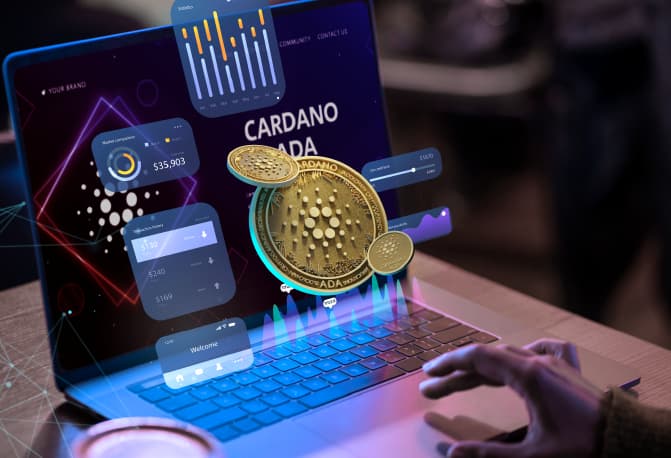If you’re just starting in cryptocurrency, you may feel a little overwhelmed. With so many coins and tokens available, it can be challenging to know where to begin. In this beginner’s guide to cryptocurrency, we’ll take you through the basics and show you how to get started.
Table Of Contents:
What Is Cryptocurrency?
Cryptocurrency is a digital or virtual asset designed to work as a medium of exchange. It uses cryptography to secure its transactions and control the creation of new units. Cryptocurrencies are decentralized, not subject to government or financial institution control.
It is a relatively new technology, and its future is still uncertain. However, there is no doubt that it is here to stay and will play a major role in the future of finance.
Cryptocurrency Exchanges
Cryptocurrency exchanges are websites where you can buy, sell, or trade cryptocurrencies. There are a number of different exchanges available, each with its own set of features and benefits. When choosing an exchange, it’s important to consider the following factors:
- The type of cryptocurrencies available
- The number of currencies supported
- The trading fees
- The withdrawal fees
- The security features
- The customer support
How Does Cryptocurrency Work?
Crypto transactions take place between users directly, without the need for a third party. Each transaction is verified by a network of nodes and recorded in a public ledger using blockchain technology. This verification process is called mining.
Mining is a computationally-intensive process that requires powerful hardware. Miners are rewarded for their efforts with tokens.
Cryptocurrency Market
The cryptocurrency market is a volatile and ever-changing environment. Prices can rise and fall rapidly and can be affected by many factors. Some of the most common factors include:
- News events
- Government regulation
- Market sentiment
- Investor sentiment
- Technical analysis
Why Use Cryptocurrency?
There are many reasons people choose to use cryptocurrency. Some of the benefits include:
Censorship Resistance:
Cryptocurrency is not subject to government or financial institution control, making it an ideal choice for those looking for a more censorship-resistant currency.
Faster and Cheaper Transactions:
Cryptocurrency transactions are faster and cheaper than traditional methods such as bank transfers.
Security:
Cryptocurrency transactions are secure and irreversible, making them ideal for online payments.
How to Get Started With Cryptocurrency

Now that you know the basics of cryptocurrency, it’s time to get started.
The first step is to create a cryptocurrency wallet. A wallet is a digital repository where you can store your cryptocurrency tokens. There are many different types of wallets available, so be sure to choose one right for you.
Once you have a wallet, you can start buying cryptocurrency. The most popular way to buy cryptocurrency is through an online exchange. There are many exchanges available, so be sure to do your research before choosing one.
Once you have bought cryptocurrency, you can start trading it. Cryptocurrency trading can be risky, so do your research before getting started.
How Do I Store Cryptocurrency?
Cryptocurrencies are stored in digital wallets. Many different wallets are available, each with its own set of features and security measures. It is important to choose a wallet that meets your needs and is compatible with your cryptocurrency.
Common Terms Associated With Cryptocurrency
What Is Cryptography?
Cryptography is the practice of secure communication in the presence of third parties. It is used in cryptocurrency to secure transactions and control the creation of new units. Cryptography is also used to protect digital assets, such as passwords and user data.
What Is a Blockchain?
A blockchain is a distributed database that allows for secure, transparent, and tamper-proof transactions. Transactions are verified by network nodes and recorded in a public ledger.
What Is a Distributed Ledger?
A distributed ledger is a database spread across multiple nodes or servers. This allows for secure, transparent, and tamper-proof transactions.
Distributed ledger technology is used in cryptocurrency to create a tamper-proof record of transactions.
What Is a Node?
A node is a computer that participates in a cryptocurrency network. Nodes verify transactions and record them in a public ledger.
What Is a Digital Asset?
A digital asset is a type of Cryptocurrency stored in a digital wallet. Digital assets are often used to purchase goods and services online.
What Is a Distributed Database?
A distributed database is a database that is shared by multiple network nodes. Transactions are verified by network nodes and recorded in a public ledger. This allows for secure, transparent, and tamper-proof transactions.
What Is a Digital Wallet?
A digital wallet is a software application that stores digital assets such as cryptocurrencies. Digital wallets come in many different types, each with its own set of features and security measures. It is important to choose a wallet that meets your needs and is compatible with your cryptocurrency.
What Is a Peer-To-Peer Exchange?
A peer-to-peer exchange is a type of cryptocurrency exchange that allows users to trade cryptocurrencies directly. This eliminates the need for a third party, such as an online exchange. Peer-to-peer exchanges often have lower fees than other types of exchanges.
What Is Digital Currency?
A digital currency is a type of cryptocurrency that is used in online transactions. Digital currencies are often used to purchase goods and services online.
What Is a Public Ledger?
A public ledger is a record of all cryptocurrency transactions. Transactions are verified by network nodes and recorded in a public ledger. This allows for secure, transparent, and tamper-proof transactions.
What Are Blockchain Transactions?
Blockchain transactions refer to the process of verifying and recording crypto transactions in a public ledger. This allows for secure, transparent, and tamper-proof transactions.
What Is a Digital Signature?
A digital signature is a type of authentication that uses cryptography to verify the identity of the sender. Digital signatures are often used in crypto transactions to ensure the security of the transaction.
What Is a Private Key?
A private key is a type of authentication that uses cryptography to verify the identity of the sender. Private keys are often used in crypto transactions to ensure the security of the transaction.
What Is a Blockchain Wallet?
A blockchain wallet is a digital wallet that uses blockchain technology to store cryptocurrencies. Blockchain wallets allow you to send and receive cryptocurrencies and monitor your balance and transactions. Blockchain wallets are decentralized, not subject to government or financial institution control.
What Is a Bitcoin?
A Bitcoin is a type of cryptocurrency that is most commonly used on online exchanges. Bitcoin is a decentralized currency, not subject to government or financial institution control. Bitcoin transactions are verified by network nodes and recorded in a public ledger.
What Is the Difference Between Cryptocurrency and Fiat Currency?
Cryptocurrencies are digital assets that use cryptography to secure their transactions and control the creation of new units.
Fiat currencies are government-backed currencies that are used as legal tender. Cryptocurrencies are not subject to government or financial institution control, whereas fiat currencies are.
Why Have Cryptocurrencies Gained So Much Attention?

Cryptocurrencies have gained attention in recent years because they offer a number of advantages over traditional currencies. These advantages include:
Decentralization:
Cryptocurrencies are not subject to government or financial institution control, allowing greater freedom and privacy.
Security:
Cryptocurrencies are secured by cryptography, which makes them difficult to hack.
Anonymity:
Transactions made with cryptocurrencies are often anonymous, appealing to those looking for privacy.
Fees:
Crypto transactions are often much cheaper than traditional currency transactions.
Speed:
Cryptocurrency transactions are often completed more quickly than traditional currency transactions
What Is Cryptocurrency Mining?

Mining is the process of verifying and recording transactions on the blockchain. Miners are rewarded with cryptocurrency for their efforts. The type of Cryptocurrency that is mined depends on the algorithm used. Bitcoin, for example, is mined using the SHA-256 algorithm.
Who Are Miners?
Miners are individuals or groups who use their computing power to verify and record cryptocurrency transactions. Miners are rewarded with cryptocurrency for their efforts.
How Is Cryptocurrency Mining Done?
Mining is done by using special software to solve complex mathematical problems. When a problem is solved, the miner is rewarded with cryptocurrency.
How Does Cryptocurrency Enter Circulation?
Cryptocurrency enters circulation when it is mined. This cryptocurrency is then used to conduct transactions. Miners are rewarded with cryptocurrency for verifying and recording transactions on the blockchain.
Classification of Cryptocurrencies
Cryptocurrencies can be classified in a number of ways. One way is by the algorithm that is used to mine them. Bitcoin, for example, is mined using the SHA-256 algorithm. Another way to classify cryptocurrencies is by their purpose. Some cryptocurrencies are designed specifically for payment methods, while others are intended for use as investments.
It is further classified into two categories: Coins and Tokens.
Coins
Coins are cryptocurrencies that are used as a form of currency. Bitcoin, for example, is a coin. Coins are often used to conduct transactions and to store value.
Tokens
Tokens are cryptocurrencies that are not used as a form of currency. Instead, tokens are used to represent assets or rights. Tokens are often used to issue shares, represent ownership interests, or provide access to a service or product. Ethereum, for example, is a token.
What Is the Difference Between a Coin and a Token?
The main difference between coins and tokens is that coins are used as currency, whereas tokens are not. Coins are often used to conduct transactions and to store value. Tokens, on the other hand, are used to represent assets or rights. Tokens are often used to issue shares, represent ownership interests, or provide access to a service or product. Ethereum, for example, is a token.
Crypto Assets
Cryptocurrencies are just one type of cryptocurrency asset. There are a number of other types of crypto assets, including:
Tokens:
Tokens are created on top of existing cryptocurrencies, such as Ethereum or Bitcoin. They can be used to represent anything, from ownership of a company to voting rights in a decentralized application.
Utility Tokens:
Utility tokens are used to purchase goods or services within a particular ecosystem. For example, the Kin token is used to pay for content and services on the Kik messaging platform.
Tokenized Assets:
Tokenized assets are digital assets that are represented by a blockchain token. These assets can be anything, from gold to real estate.
Security Tokens:
Security tokens are digital assets that represent ownership of a real-world asset. They are similar to traditional securities, such as stocks and bonds
What Are the Most Popular Cryptocurrencies?

The most popular cryptocurrencies include Bitcoin, Ethereum, and Litecoin. These cryptocurrencies have the largest market caps and are the most widely traded.
Bitcoin is the original cryptocurrency and is used as a payment method.
Ethereum is a second-generation cryptocurrency that offers smart contract functionality.
Litecoin is a third-generation cryptocurrency that offers faster transaction speeds than Bitcoin
Types of Cryptocurrencies
There are different types of cryptocurrencies, which are classified by their purpose or algorithm. Bitcoin, Ethereum, and Litecoin are all examples of coins. There are multiple types of tokens, which are classified by the type of asset they represent.
The following are some of them:
Bitcoin
Bitcoin is the original cryptocurrency and is used as a payment method.
Ethereum
Ethereum is a second-generation cryptocurrency that offers smart contract functionality.
Litecoin
Litecoin is a third-generation cryptocurrency that offers faster transaction speeds than Bitcoin.
Ripple
Ripple is a settlement network that uses cryptocurrency to facilitate cross-border payments.
Bitcoin Cash
Bitcoin Cash is a fork of Bitcoin that offers larger block sizes.
NEO
NEO is a Chinese cryptocurrency that offers smart contract functionality.
Cardano
Cardano is a decentralized blockchain platform that uses Proof of Stake.
Stellar
Stellar is a payment network that uses cryptocurrency to facilitate cross-border payments.
IOTA
IOTA is a cryptocurrency that uses the Tangle ledger
Monero
Monero is a privacy-focused cryptocurrency that uses Ring Signatures.
Dash
Dash is a privacy-focused cryptocurrency that offers InstantSend and PrivateSend functionality.
Zcash
Zcash is a privacy-focused cryptocurrency that offers shielded transactions.
BitShares
BitShares is a decentralized exchange that uses cryptocurrency to facilitate trading.
EOS
EOS is a blockchain platform that offers smart contract functionality.
NEM
NEM is a blockchain platform that offers smart contract functionality.
Lisk
Lisk is a decentralized blockchain platform that uses Sidechains.
Tron
Tron is a decentralized entertainment protocol that uses cryptocurrency to facilitate transactions.
Tezos
Tezos is a decentralized blockchain platform that uses Proof of Stake.
TRON
Tron is a decentralized entertainment protocol that uses cryptocurrency to facilitate transactions.
Ontology
Ontology is a decentralized trust management platform that uses blockchain technology.
Oyster
Oyster is a decentralized storage network that uses cryptocurrency to facilitate payments.
ICON
ICON is a decentralized blockchain platform that uses Smart Contracts.
Nano
Nano is a cryptocurrency that offers instant transactions.
VeChain
VeChain is a supply chain management platform that uses blockchain technology.
Dogecoin
Dogecoin is a cryptocurrency that was created as a joke. However, it has become quite popular and is used as a payment method.
Binance Coin
Binance Coin is a cryptocurrency used to pay for fees on the Binance cryptocurrency exchange.
Augur
Augur is a decentralized prediction market that uses cryptocurrency to facilitate payments.
Gnosis
Gnosis is a decentralized prediction market that uses cryptocurrency to facilitate payments.
Basic Attention Token
Basic Attention Token is a cryptocurrency used to pay for advertising on the Brave browser.
There are many other cryptocurrencies, each with unique features. It is important to do your research before investing in any cryptocurrency.
How to Measure the Value of Cryptocurrency
Since the launch of Bitcoin in 2009, the cryptocurrency market has seen immense growth. There are now over 1,600 types of Cryptocurrency available, with a total market capitalization of over $200 billion.
Despite this impressive growth, there is still significant debate about the future of cryptocurrency. Some experts believe that Cryptocurrency will eventually replace fiat currency, while others think it will become a niche investment.
So, how can we measure the value of cryptocurrency?
One way to do this is to look at the total market capitalization of all cryptocurrencies. This can give us an idea of how much interest there is in the asset class and how much money is invested. Another way to measure the value of cryptocurrency is to look at its use case. For example, some cryptocurrencies are better suited for payments, while others are better for investment.
It is also important to remember that the value of cryptocurrency is highly volatile. This means that it can experience large price swings in a short amount of time. Doing your research before investing any money into this asset class is important.
What Is the Future of Cryptocurrencies?
Cryptocurrencies first burst onto the scene in 2009 with the launch of Bitcoin. Since then, they have become a global phenomenon, with over 18 million Bitcoins currently in circulation. But what does the future hold for cryptocurrencies?
While some experts have predicted that Bitcoin will become the global reserve currency, others have cautioned that the volatile nature of cryptocurrency markets makes them too risky for widespread adoption.
One thing is certain: the future of cryptocurrencies is shrouded in uncertainty. However, cryptocurrencies are here to stay. With their potential to revolutionize the way we interact with the world economy, it is only a matter of time before they become a mainstream force. Only time will tell what the future holds for cryptocurrencies, but they are a force to be reckoned with.
What Are You Waiting For?
Get started with cryptocurrencies today! Don’t miss out on this exciting new investment opportunity! Visit our website to learn more about the different types of cryptocurrency available and how to get started.




























